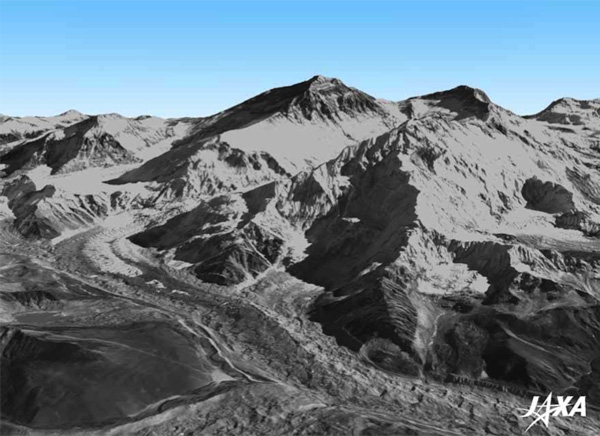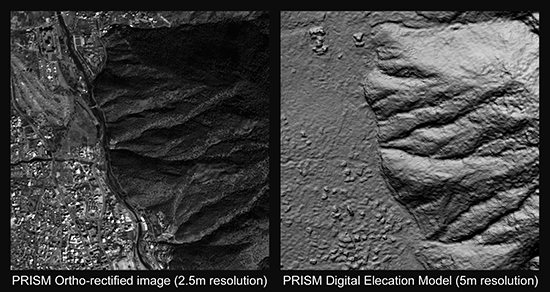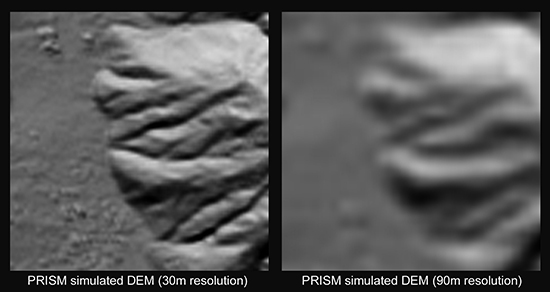DAICHI Data Application for Compilation of
Global Digital 3D Map with World's Best Precision
Japan Aerospace Exploration Agency (JAXA)
The Japan Aerospace Exploration Agency (JAXA) will compile the global digital 3D map with the highest precision in the world using some 3 million data images acquired by the Advanced Land Observing Satellite "DAICHI" (ALOS).
The digital 3D map to be compiled this time has the world's best precision of five meters in spatial resolution with five meters height accuracy that enables us to express land terrain all over the world. Hence its strong character will prove useful in various areas including mapping, damage prediction of a natural disaster, water resource research etc.

Digital 3D Map Image Example: Mt. Everest
JAXA has been compiling about 100 digital 3D maps per month as part of our engineering validation activities of DAICHI. As we conducted research and development for full automatic and mass processing map compilations, we now have a perspective to process 150,000 maps per month. By applying our research and development results, we will start the 3D map compilation in March 2014 to complete the global 3D map in March 2016. JAXA will commission the compiling work and service provision to NTT DATA Corporation.
In order to popularize the utilization of the 3D map data, JAXA will also prepare global digital elevation model (DEM) with lower spatial resolution (of about 30 meters under our current plan) to publish it as soon as it is ready. Its use will be free of charge. We expect that data from Japan will become the base map for all global digital 3D maps.
Related links
|
|
1.Background
The needs for geographic spatial information are increasing all over the world to organize basic map information and prepare for disasters such as tsunamis and floods, etc. 3D maps are essential for organizing geographic spatial information, but, to date, manpower and airplanes were required to compile 3D maps thus such processes were limited due to cost and time constraints.
The satellite DAICHI* observed land areas all over the globe, but organizing its data to cover such broad areas has stalled due to the constraints of some challenges and the computation ability for automation in 3D mapping technology
2.Special features
< What is a digital 3D map? >
A digital 3D map is data with 3D axes of coordinates (geolocation and height). It consists of a digital elevation model (DEM) and ortho-rectified images that indicate geolocation. An ortho-rectified image is an image that entails correct position information by eliminating terrain distortion on an image that was caused by taking images from above the sky.
< Digital 3D map with highest precision in the world >
The DEM of the digital 3D map to be processed by JAXA will express land undulations all over world with the precision of five meters of spatial resolution (and 2.5 meters for ortho-rectified images) with five meters of height accuracy by utilizing about 3 million data images that are less cloud cover acquired by the Panchromatic Remote-sensing instrument for Stereo Mapping (PRISM) aboard the DAICHI.
Similar DEM of a global scale organized in the past include a model with a spatial resolution of 90 meters released by the U.S. in 2000 utilizing observation data from Space Shuttles (its first version was published in 2003), and one with a resolution of 30 meters released jointly by Japan (Ministry of Economy, Trade and Industry) and the U.S. applying satellite observation images since 2000 (its first version was published in 2009.) Both are still broadly used.
Figure 2 shows images of Thimphu, Kingdom of Bhutan. The left image is an ortho-rectified image, and the right is a DEM. For your reference, Figure 3 shows simulated DEMs based on Figure 2's DEM. In Figure 3, the resolution of the left image is 30 meters while that of the right image is 90 meters.

Figure 2: Example of digital 3D map in the Kingdom of Bhutan
(Left: Ortho-rectified image with 2.5 meter resolution
Right: Digital elevation model with 5 meter resolution)

Figure 3: Simulated DEMs from Figure 2 (for reference)
(Left: 30-meter resolution / Right: 90-meter resolution)
* The Advanced Land Observing Satellite "DAICHI" (ALOS) was launched in January 2006 by JAXA and was used in mission operations for five years and four months till May 2011. It observed various conditions of the Earth till the completion of its operations. The DAICHI is equipped with the Panchromatic Remote-sensing instrument for Stereo Mapping (PRISM) that enabled its observations with a high-resolution three-dimensional view.